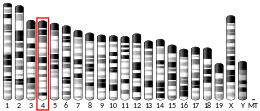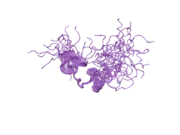LIN28
Lin-28 homolog A is a protein that in humans is encoded by the LIN28 gene.[5][6]
LIN28 encodes an RNA-binding protein[7] that binds to and enhances the translation of the IGF-2 (insulin-like growth factor 2) mRNA.[8] Lin28 binds to the let-7 pre-microRNA and blocks production of the mature let-7 microRNA in mouse embryonic stem cells.[9][10] In pluripotent embryonal carcinoma cells, LIN28 is localized in the ribosomes, P-bodies and stress granules.[11]
Function
Stem cell expression
LIN28 is thought to regulate the self-renewal of stem cells. In Caenorhabditis elegans, there is only one Lin28 gene that is expressed and in vertebrates, there are two paralogs present, Lin28a and Lin28b. In nematodes, the LIN28 homolog lin-28 is a heterochronic gene that determines the onset of early larval stages of developmental events in C. elegans, by regulating the self-renewal of nematode stem cells in the skin (called seam cells) and vulva (called VPCs) during development.[12] In mice, LIN28 is highly expressed in mouse embryonic stem cells and during early embryogenesis.[13]
LIN28 is highly expressed in human embryonic stem cells[14] and can enhance the efficiency of the formation of induced pluripotent stem (iPS) cells from human fibroblasts.[15]
Puberty
LIN28 overexpression in mice can cause gigantism and a delay in puberty onset, consistent with human genome-wide association studies suggesting that polymorphisms in the human LIN28B gene are associated with human height and puberty timing.[16] Mutations in LIN28B are associated with precocious puberty.[17]
LIN28 can regulate glucose homeostasis in mammals by increasing insulin-PI3K-mTOR signaling and insulin sensitivity, thereby promoting resistance to high fat diet-induced obesity and type 2 diabetes.[18] Aberrant expression of LIN28 has been seen to regulate aerobic glycolysis to facilitate cancer proliferation
Tissue regeneration
Mice genetically altered to produce LIN28 during their lifespan showed improved hair growth[19] and healthy tissue regeneration on added puncture wounds[19] in later life stages.[19] While the mice could regenerate limbs, they could not repair damaged heart tissue. Appropriate drugs replicated the regeneration in unaltered mice, using the same metabolic paths. The drugs increased the subjects' metabolic rates, evidently causing the body to heal at higher rates. The effects of Lin28a activation faded with age.[19][20]
Structure
Models of Lin28/let-7 complexes obtained through X-ray crystallography and NMR reveal that two folded domains of Lin28 recognize two distinct RNA regions.[21][22] The domains are sufficient for inhibition of let-7 in vivo.[10][23]
Applications
LIN28 is a marker of undifferentiated human embryonic stem cells[14] and has been used to enhance the efficiency of the formation of iPS cells from human fibroblasts.[15]
References
- GRCh38: Ensembl release 89: ENSG00000131914 - Ensembl, May 2017
- GRCm38: Ensembl release 89: ENSMUSG00000050966 - Ensembl, May 2017
- "Human PubMed Reference:". National Center for Biotechnology Information, U.S. National Library of Medicine.
- "Mouse PubMed Reference:". National Center for Biotechnology Information, U.S. National Library of Medicine.
- Moss EG, Tang L (Jun 2003). "Conservation of the heterochronic regulator Lin-28, its developmental expression and microRNA complementary sites". Developmental Biology. 258 (2): 432–42. doi:10.1016/S0012-1606(03)00126-X. PMID 12798299.
- "Entrez Gene: LIN28 lin-28 homolog (C. elegans)".
- Tsialikas J, Romer-Seibert J (Jul 2015). "LIN28: roles and regulation in development and beyond". Development. 142 (14): 2397–404. doi:10.1242/dev.117580. PMID 26199409.
- Polesskaya A, Cuvellier S, Naguibneva I, Duquet A, Moss EG, Harel-Bellan A (May 2007). "Lin-28 binds IGF-2 mRNA and participates in skeletal myogenesis by increasing translation efficiency". Genes & Development. 21 (9): 1125–38. doi:10.1101/gad.415007. PMC 1855237. PMID 17473174.
- Viswanathan SR, Daley GQ, Gregory RI (Apr 2008). "Selective blockade of microRNA processing by Lin28". Science. 320 (5872): 97–100. Bibcode:2008Sci...320...97V. doi:10.1126/science.1154040. PMC 3368499. PMID 18292307.
- Ali PS, Ghoshdastider U, Hoffmann J, Brutschy B, Filipek S (Nov 2012). "Recognition of the let-7g miRNA precursor by human Lin28B". FEBS Letters. 586 (22): 3986–90. doi:10.1016/j.febslet.2012.09.034. PMID 23063642. S2CID 28899778.
- Balzer E, Moss EG (2007). "Localization of the developmental timing regulator Lin28 to mRNP complexes, P-bodies and stress granules". RNA Biology. 4 (1): 16–25. doi:10.4161/rna.4.1.4364. PMID 17617744.
- Moss EG, Lee RC, Ambros V (Mar 1997). "The cold shock domain protein LIN-28 controls developmental timing in C. elegans and is regulated by the lin-4 RNA". Cell. 88 (5): 637–46. doi:10.1016/s0092-8674(00)81906-6. PMID 9054503. S2CID 13248841.
- Yang DH, Moss EG (Dec 2003). "Temporally regulated expression of Lin-28 in diverse tissues of the developing mouse". Gene Expression Patterns. 3 (6): 719–26. doi:10.1016/s1567-133x(03)00140-6. PMID 14643679.
- Richards M, Tan SP, Tan JH, Chan WK, Bongso A (2004). "The transcriptome profile of human embryonic stem cells as defined by SAGE". Stem Cells. 22 (1): 51–64. doi:10.1634/stemcells.22-1-51. PMID 14688391.
- Yu J, Vodyanik MA, Smuga-Otto K, Antosiewicz-Bourget J, Frane JL, Tian S, Nie J, Jonsdottir GA, Ruotti V, Stewart R, Slukvin II, Thomson JA (Dec 2007). "Induced pluripotent stem cell lines derived from human somatic cells". Science. 318 (5858): 1917–20. Bibcode:2007Sci...318.1917Y. doi:10.1126/science.1151526. PMID 18029452. S2CID 86129154.
- Zhu H, Shah S, Shyh-Chang N, Shinoda G, Einhorn WS, Viswanathan SR, Takeuchi A, Grasemann C, Rinn JL, Lopez MF, Hirschhorn JN, Palmert MR, Daley GQ (Jul 2010). "Lin28a transgenic mice manifest size and puberty phenotypes identified in human genetic association studies". Nature Genetics. 42 (7): 626–30. doi:10.1038/ng.593. PMC 3069638. PMID 20512147.
- Park SW, Lee ST, Sohn YB, Cho SY, Kim SH, Kim SJ, Kim CH, Ko AR, Paik KH, Kim JW, Jin DK (Oct 2012). "LIN28B polymorphisms are associated with central precocious puberty and early puberty in girls". Korean Journal of Pediatrics. 55 (10): 388–92. doi:10.3345/kjp.2012.55.10.388. PMC 3488615. PMID 23133486.
- Zhu H, Shyh-Chang N, Segrè AV, Shinoda G, Shah SP, Einhorn WS, Takeuchi A, Engreitz JM, Hagan JP, Kharas MG, Urbach A, Thornton JE, Triboulet R, Gregory RI, Altshuler D, Daley GQ (Sep 2011). "The Lin28/let-7 axis regulates glucose metabolism". Cell. 147 (1): 81–94. doi:10.1016/j.cell.2011.08.033. PMC 3353524. PMID 21962509.
- Shyh-Chang N, Zhu H, Yvanka de Soysa T, Shinoda G, Seligson MT, Tsanov KM, Nguyen L, Asara JM, Cantley LC, Daley GQ (Nov 2013). "Lin28 enhances tissue repair by reprogramming cellular metabolism". Cell. 155 (4): 778–792. doi:10.1016/j.cell.2013.09.059. PMC 3917449. PMID 24209617.
- Fine D (November 7, 2013). "New Limb Regeneration Insight Surprises Scientists". Scientific American.
- Shyh-Chang N, Daley GQ (Apr 2013). "Lin28: primal regulator of growth and metabolism in stem cells". Cell Stem Cell. 12 (4): 395–406. doi:10.1016/j.stem.2013.03.005. PMC 3652335. PMID 23561442.
- Nam, Yunsun; Chen, Casandra; Gregory, Richard I.; Chou, James J.; Sliz, Piotr (November 2011). "Molecular Basis for Interaction of let-7 MicroRNAs with Lin28". Cell. 147 (5): 1080–1091. doi:10.1016/j.cell.2011.10.020. PMC 3277843. PMID 22078496.
- Loughlin, Fionna E; Gebert, Luca F R; Towbin, Harry; Brunschweiger, Andreas; Hall, Jonathan; Allain, Frédéric H-T (11 December 2011). "Structural basis of pre-let-7 miRNA recognition by the zinc knuckles of pluripotency factor Lin28". Nature Structural & Molecular Biology. 19 (1): 84–89. doi:10.1038/nsmb.2202. PMID 22157959. S2CID 2201304.
- PDB: 3TS2; Nam Y, Chen C, Gregory RI, Chou JJ, Sliz P (Nov 2011). "Molecular basis for interaction of let-7 microRNAs with Lin28". Cell. 147 (5): 1080–91. doi:10.1016/j.cell.2011.10.020. PMC 3277843. PMID 22078496.
Further reading
- Richards M, Tan SP, Tan JH, Chan WK, Bongso A (2004). "The transcriptome profile of human embryonic stem cells as defined by SAGE". Stem Cells. 22 (1): 51–64. doi:10.1634/stemcells.22-1-51. PMID 14688391.
- Sempere LF, Freemantle S, Pitha-Rowe I, Moss E, Dmitrovsky E, Ambros V (2004). "Expression profiling of mammalian microRNAs uncovers a subset of brain-expressed microRNAs with possible roles in murine and human neuronal differentiation". Genome Biology. 5 (3): R13. doi:10.1186/gb-2004-5-3-r13. PMC 395763. PMID 15003116.
- Gerecht-Nir S, Dazard JE, Golan-Mashiach M, Osenberg S, Botvinnik A, Amariglio N, Domany E, Rechavi G, Givol D, Itskovitz-Eldor J (Feb 2005). "Vascular gene expression and phenotypic correlation during differentiation of human embryonic stem cells". Developmental Dynamics. 232 (2): 487–97. doi:10.1002/dvdy.20247. PMID 15614775. S2CID 3006762.
- Lee YS, Kim HK, Chung S, Kim KS, Dutta A (Apr 2005). "Depletion of human micro-RNA miR-125b reveals that it is critical for the proliferation of differentiated cells but not for the down-regulation of putative targets during differentiation". The Journal of Biological Chemistry. 280 (17): 16635–41. doi:10.1074/jbc.M412247200. PMID 15722555.
- Wu L, Belasco JG (Nov 2005). "Micro-RNA regulation of the mammalian lin-28 gene during neuronal differentiation of embryonal carcinoma cells". Molecular and Cellular Biology. 25 (21): 9198–208. doi:10.1128/MCB.25.21.9198-9208.2005. PMC 1265813. PMID 16227573.
.png.webp)





